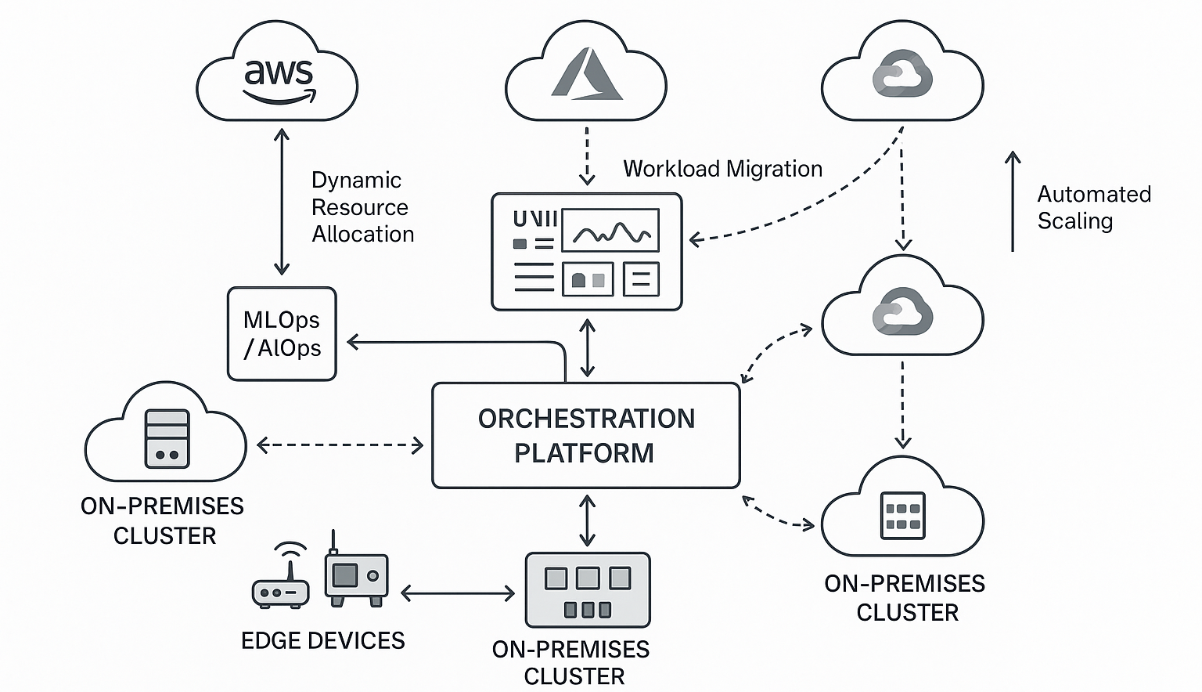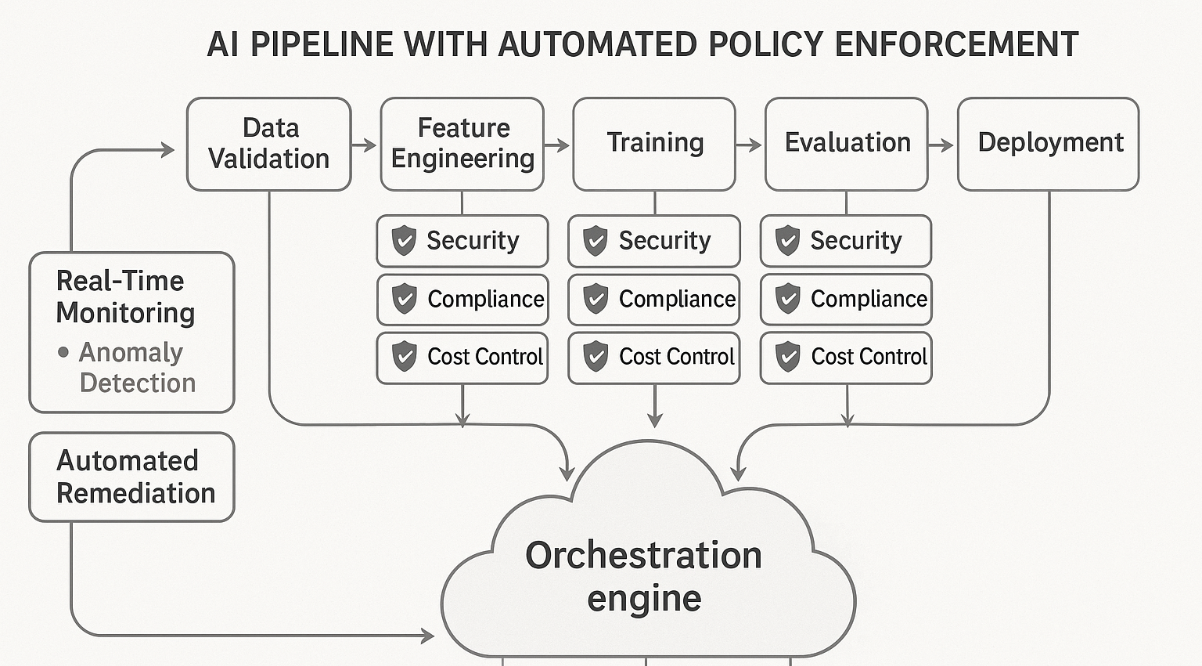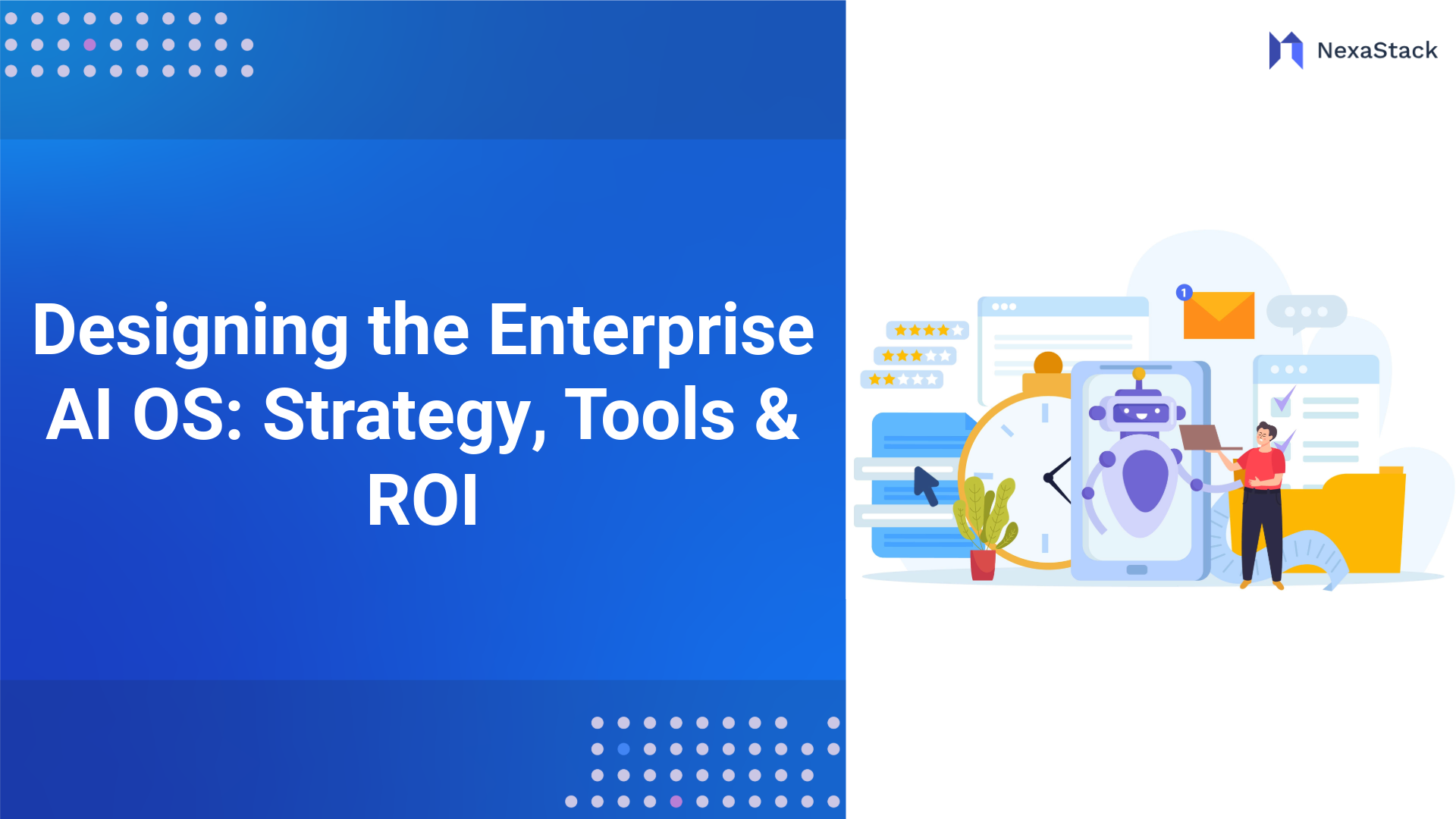As organisations accelerate their artificial intelligence (AI) journeys, many find themselves overwhelmed by infrastructure sprawl, unpredictable workloads, and fragmented pipelines. Manual interventions, compliance risks, and resource bottlenecks can quickly stall even the most promising AI initiatives. This is where intelligent AI workload orchestration steps in, bringing advanced automation, real-time analytics, and policy-driven control to the heart of AI operations.
Unlike basic scheduling tools, platforms such as Kubeflow, NVIDIA AI Enterprise, and AWS SageMaker dynamically optimise workloads, integrate seamlessly with MLOps and AIOps, and enforce compliance across hybrid and multi-cloud environments. For regulated sectors like finance, healthcare, and telecom, intelligent orchestration is the key to transforming AI chaos into control, enabling scalable, resilient, and future-ready digital enterprises.
Why AI Workloads Spiral Out of Control
AI adoption brings immense promise, but as organisations scale, they often face a storm of operational challenges:
-
Infrastructure Sprawl: AI workloads demand significant compute, storage, and network resources, leading to tangled environments that are difficult to manage.
-
Fragmented Pipelines: Diverse tools and frameworks often result in integration headaches and workflow silos.
-
Manual Interventions: Without automation, deployment and scaling become error-prone and slow.
-
Unpredictable Resource Demands: Fluctuating needs for compute and storage can cause over-provisioning or bottlenecks.
-
Compliance and Security Risks: Disjointed systems make it challenging to enforce policies and protect sensitive data.
The Urgency for Intelligent Orchestration
The complexity and scale of modern AI initiatives demand a new approach. Intelligent AI workload orchestration is not just a technical upgrade; it’s a strategic imperative for organizations aiming to:
-
Accelerate AI Deployment: Automation eliminates manual bottlenecks for faster time-to-market.
-
Optimize Resource Utilization: Dynamic allocation reduces costs and maximizes performance.
-
Enhance Compliance and Security: Centralized policy enforcement simplifies regulatory adherence and data protection.
-
Enable Scalability: Seamless scaling across hybrid and multi-cloud environments supports growth without chaos.
-
Maintain Operational Visibility: Real-time monitoring delivers transparency and proactive management.
With intelligent orchestration, enterprises can transform AI chaos into control, laying the groundwork for resilient, scalable, and future-ready digital operations.
Defining Intelligent AI Workload Orchestration
What It Is and Why It Matters
Intelligent AI workload orchestration is the automated, policy-driven management of AI and machine learning tasks across complex, distributed infrastructure. Unlike traditional job schedulers, intelligent orchestration platforms leverage advanced analytics, machine learning, and dynamic resource allocation to optimise every stage of the AI lifecycle from data ingestion and model training to deployment and monitoring.
This approach is crucial because AI workloads are inherently dynamic. Models may require retraining at unpredictable intervals, inference demands can spike with user activity, and data pipelines must adapt to evolving business needs. Intelligent orchestration ensures that resources are provisioned and scaled automatically, workloads are prioritised based on business value, and compliance is maintained across environments. 
Fig 1. AI Workload Orchestration Across Hybrid and Multi-Cloud
Key Differences from Basic Orchestration Tools
While basic orchestration tools handle simple scheduling and resource allocation, intelligent AI workload orchestration platforms offer a suite of advanced capabilities:
-
Context-Aware Scheduling: Platforms like NexaStack and Akira AI understand the unique requirements of AI tasks, such as GPU vs. CPU allocation, data locality, and dependency management.
-
Policy-Driven Automation: Intelligent orchestration automatically enforces organisational policies for security, compliance, and cost control, reducing human error.
-
Self-Healing and Auto-Remediation: Advanced platforms detect failures or performance issues and take corrective action without manual intervention.
By moving beyond basic scheduling, intelligent AI workload orchestration empowers organisations to maximise their AI investments, accelerate innovation, and maintain control even as complexity grows. For enterprises operating in regulated sectors or managing large-scale AI deployments, this level of orchestration is not just beneficial but it’s essential for sustainable success.
Core Features of Intelligent Orchestration Platforms
Effectively managing AI at scale requires more than just automating routine tasks; organisations need orchestration platforms that bring intelligence, adaptability, and seamless integration to every layer of AI operations. Intelligent AI workload orchestration platforms unify automation, policy enforcement, and advanced analytics, empowering teams to run complex workloads efficiently, securely, and with full transparency.
-
Auto-Scaling and Resource Optimisation: Platforms like NexaStack and Akira AI (from XenonStack) use predictive analytics to adjust compute automatically and storage resources based on real-time needs. This ensures high performance while keeping costs under control.
-
Automated Dependency Management: These platforms map and manage dependencies within AI pipelines, using workflow automation to detect bottlenecks early and keep processes running smoothly.
-
Policy Enforcement and Compliance: With built-in policy controls and continuous monitoring, intelligent orchestration helps organisations meet regulatory and security requirements across hybrid and multi-cloud environments.

Fig 2. AI pipeline with automated policy enforcement
Benefits: From Manual Struggles to Automated Control
Adopting intelligent AI workload orchestration transforms how enterprises manage and scale their AI initiatives. Organisations unlock significant benefits by shifting from manual, reactive processes to automated, policy-driven control.
-
Faster Deployments and Time-to-Value
Automated orchestration accelerates every stage of the AI lifecycle from data ingestion to model deployment, enabling teams to launch new solutions rapidly. This speed helps businesses respond to market opportunities and changing customer needs with agility.
-
Lower Operational Costs
Dynamic resource allocation and predictive scaling minimize over-provisioning and reduce infrastructure waste. Platforms like NexaStack and Akira AI help organizations optimize spending while maintaining high performance.
-
Improved Model Performance
Intelligent orchestration ensures that AI models run efficiently and reliably by continuously monitoring workloads and automatically resolving bottlenecks. This leads to better outcomes and more robust, production-ready solutions.
-
Enhanced Compliance and Security
Automated policy enforcement and real-time monitoring simplify regulatory compliance and strengthen security. Enterprises can meet industry standards especially in regulated sectors like finance, healthcare, and telecom with less manual oversight.
-
Greater Operational Visibility
Centralised dashboards and analytics provide real-time insights into resource usage, system health, and compliance status. This transparency empowers proactive decision-making and supports continuous improvement.
With these advantages, intelligent orchestration platforms move enterprises from reactive management to proactive, automated control, laying the foundation for scalable, secure, and future-ready AI operations.
Enterprise Use Cases Across Regulated Sectors
Intelligent AI workload orchestration is reshaping how highly regulated industries manage complexity, compliance, and scale. By automating resource allocation and enforcing policies, these platforms address some of the most pressing challenges in sectors like finance, healthcare, and telecom.
-
Finance: Financial institutions must balance innovation with strict regulatory requirements and data privacy standards. Intelligent orchestration streamlines model deployment, automates compliance checks, and ensures secure data handling—reducing the risk of costly errors and regulatory breaches. This enables faster rollout of AI-powered services, from fraud detection to risk assessment, while maintaining operational resilience.
-
Healthcare: Healthcare organizations struggle with fragmented data, legacy systems, and stringent privacy laws. Orchestration platforms help unify workflows, automate data integration, and enforce HIPAA and GDPR compliance. This leads to more efficient patient care, improved diagnostics, and accelerated research, all while safeguarding sensitive information.
-
Telecom: Telecom operators face massive data volumes and the need for real-time analytics across distributed networks. Intelligent orchestration enables dynamic scaling for AI workloads, ensures high availability, and automates network monitoring and optimization. This supports reliable service delivery and rapid response to network issues, even at the edge.

Real-World Success Stories
-
Automated compliance management using AI has enabled JPMorgan Chase to improve regulatory adherence, reduce operational risk, and enhance efficiency. Their AI-driven systems monitor real-time transactions, identify compliance risks, and automate reporting—significantly cutting manual effort and error rates.
-
Johns Hopkins Hospital improved patient flow, resource allocation, and care delivery by leveraging AI-driven predictive analytics and real-time monitoring. Their command center uses machine learning to reduce wait times, optimize staffing, and proactively manage patient admissions, resulting in a 60% improvement in accepting complex cases and a 70% reduction in transfer delays.
-
Vodafone, in partnership with Nokia, deployed a machine learning-based anomaly detection system to monitor its pan-European mobile networks. This solution automatically identifies and resolves up to 80% of network anomalies in real time, improving reliability and customer experience as the network scales.
Conclusion: Scaling AI with Confidence and Control
Orchestrating AI workloads has become the backbone of successful enterprise AI, transforming what was once a landscape of chaos into a foundation of control, agility, and innovation. As organisations deploy more models and embrace hybrid, multi-cloud strategies, the complexity of managing AI at scale can no longer be addressed with manual processes or basic automation alone. Intelligent orchestration platforms unify and automate these operations, enabling seamless integration, dynamic resource allocation, and end-to-end governance.
The benefits are clear: streamlined workflows, accelerated deployments, reduced costs, and improved model performance, all while maintaining compliance and operational visibility. Real-world use cases across finance, healthcare, and telecom demonstrate that with the right orchestration tools, enterprises can achieve faster time-to-market, greater efficiency, and the ability to adapt quickly to changing business needs.
Looking ahead, the demand for intelligent AI workload orchestration will continue to surge as more companies recognise its role in unlocking the full potential of their AI investments. Future-ready AI starts with robust workload management empowering teams to innovate confidently, scale responsibly, and maintain control in an ever-evolving digital landscape.







